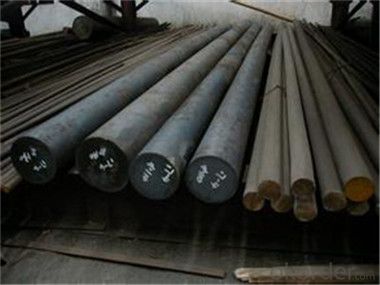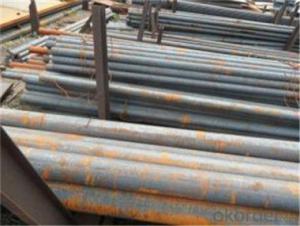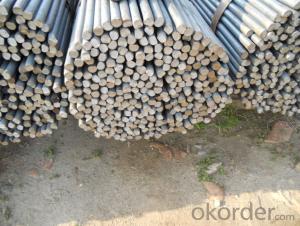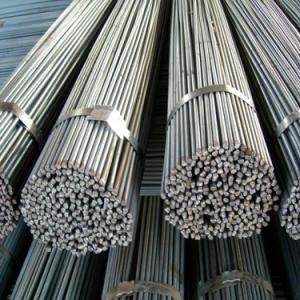Forged or Hot Rolled Sae 4140 Alloy Steel Round Bars 42CrMO SCM440
- Loading Port:
- Tianjin
- Payment Terms:
- TT OR LC
- Min Order Qty:
- 90 m.t.
- Supply Capability:
- 2000000 m.t./month
OKorder Service Pledge
OKorder Financial Service
You Might Also Like
Description of steel round bar:
1. Commodity: Round steel bar
3. Technical: Hot rolling
2. Length: Min. 5.8meter, according to requirement.
3. Diameter: 16mm-250mm
5. Packing: In Bundle or according to your requirements.
Festures of steel round bar:
1.Dia 80-800mm Length:2000-13000mm or as required
2.Technique:Forged
3.Delivery Time:45 days
Specifications of steel round bar:
1. Commodity: Round steel bar
3. Technical: Hot rolling
2. Length: Min. 5.8meter, according to requirement.
3. Diameter: 16mm-250mm
Images of steel round bar:

FAQ:
1. What is your main market?
We mainly export to Asia such as Japan,Korea,Thailand and North America and Middle East.
2. How long is the lead time?
Delivery time: 45 days after order confirmed.
3. What payment term do you accept?
Payment: T/T or L/C at sight.
- Q:How do steel round bars compare to aluminum round bars?
- Steel round bars are generally stronger and more durable than aluminum round bars. They have a higher tensile strength, making them suitable for heavy-duty applications that require high levels of strength and resistance to bending or deformation. Aluminum round bars, on the other hand, are lighter and more corrosion-resistant, making them ideal for applications that prioritize weight reduction and resistance to exposure to harsh environments. The choice between steel and aluminum round bars ultimately depends on the specific requirements of the application.
- Q:Can steel round bars be used in the manufacturing of conveyor systems?
- Yes, steel round bars can be used in the manufacturing of conveyor systems. Steel is a strong and durable material that can withstand heavy loads and provide stability and support to conveyor systems. Steel round bars can be used as rollers or shafts in conveyor systems to facilitate the movement of materials or products along the conveyor belt. The smooth surface of the round bars allows for easy rotation and reduces friction, ensuring the smooth operation of the conveyor system. Additionally, steel round bars can be easily customized to fit specific conveyor system requirements, making them versatile and suitable for various industrial applications.
- Q:What is the difference between hot rolled and cold drawn steel round bars?
- Hot rolled steel round bars undergo the process of heating a steel billet or ingot at a high temperature and subsequently rolling it into the desired shape. This process yields a rougher surface finish and a greater diameter tolerance in comparison to cold drawn steel round bars. The usage of hot rolled bars is frequently found in areas where strength and durability hold significance, such as in construction and manufacturing. On the contrary, cold drawn steel round bars are created by pulling a hot rolled bar through a die at room temperature, leading to a smoother surface finish and tighter diameter tolerances. This procedure also enhances the mechanical properties of the steel, including its strength and hardness. Cold drawn bars are often employed in scenarios where precision and a high-quality surface finish are prerequisites, like in the production of shafts, bolts, and precision components. To summarize, the principal disparities between hot rolled and cold drawn steel round bars encompass the surface finish, diameter tolerance, and mechanical properties. Hot rolled bars bear a rougher surface finish, larger diameter tolerances, and are typically utilized in contexts where strength and durability are paramount. Cold drawn bars possess a smoother surface finish, tighter diameter tolerances, and are commonly employed in situations necessitating precision and a high-quality surface finish.
- Q:How are steel round bars used in the construction of offshore structures?
- Steel round bars are commonly used in the construction of offshore structures due to their high strength and durability. These bars are typically made from carbon steel or alloy steel, which are known for their excellent mechanical properties. In offshore construction, steel round bars are primarily used to provide structural support and reinforcement. They are used in various applications, such as the construction of oil rigs, offshore platforms, pipelines, and subsea structures. One of the key uses of steel round bars is in the fabrication of piles. Piles are long, cylindrical structures that are driven into the seabed to provide a stable foundation for offshore structures. These piles are typically made from steel round bars due to their ability to withstand the harsh marine environment and high loads. Steel round bars are also used in the construction of offshore platforms. These platforms are large, elevated structures that provide a workspace for oil and gas exploration and production activities. The steel round bars are used to create the framework of the platform, forming the main structural elements such as columns, beams, and trusses. These bars are often welded or bolted together to create a strong and rigid structure capable of withstanding extreme weather conditions and heavy loads. Furthermore, steel round bars are utilized in the construction of pipelines that transport oil and gas from offshore wells to onshore facilities. These bars are used to create the pipeline supports, ensuring that the pipeline remains stable and securely fastened to the seabed. In conclusion, steel round bars play a vital role in the construction of offshore structures. Their high strength, durability, and ability to withstand harsh marine environments make them an ideal choice for providing structural support and reinforcement in offshore construction projects.
- Q:Are steel round bars recyclable?
- Indeed, recyclability is a characteristic inherent to steel round bars. Steel, being of immense value and easily recyclable, is among the most frequently recycled materials worldwide. Once steel round bars have served their purpose, they may be gathered and dispatched to a recycling facility. Within this facility, the round bars are subjected to the melting process, resulting in their conversion into novel steel products. Remarkably, this cycle can be perpetually repeated without any detrimental impact on the steel's quality. By choosing to recycle steel round bars, not only do we aid in the preservation of natural resources and the reduction of waste, but we also contribute to energy conservation and the mitigation of greenhouse gas emissions as opposed to the production of steel from raw materials.
- Q:How do you store and handle steel round bars?
- When it comes to storing and handling steel round bars, there are several important factors to consider. Firstly, it is crucial to ensure that the storage area is clean, dry, and free from any moisture or corrosive materials. This will help prevent rust and other forms of damage to the steel bars. The steel round bars should be stored horizontally, either on racks or on a flat surface, to prevent deformation or sagging. It is recommended to stack them in a way that avoids excessive pressure on any individual bar, as this could lead to bending or warping. To handle steel round bars safely, it is best to use appropriate lifting equipment such as cranes, forklifts, or hoists. Manual handling should be avoided whenever possible, as steel bars can be heavy and cumbersome. When using lifting equipment, it is important to ensure that the bars are properly secured and balanced to prevent accidents or injuries. In addition, it is essential to use protective measures such as gloves and safety shoes when handling steel round bars, as they may have sharp edges or rough surfaces. Proper personal protective equipment (PPE) should be worn to minimize the risk of cuts, abrasions, or other injuries. Regular inspections should be conducted to check for any signs of damage, such as dents, cracks, or corrosion. Any damaged bars should be separated from the rest and either repaired or discarded, depending on the severity of the damage. By following these guidelines for storage and handling, you can ensure the longevity and quality of steel round bars, while also maintaining a safe working environment for yourself and others.
- Q:How are steel round bars used in the oil and gas industry?
- Steel round bars are widely used in the oil and gas industry for various applications. One of the main uses of steel round bars is in drilling operations. They are used to manufacture drill bits and drill collars, which are essential components of drilling equipment. These drill bits and collars are subjected to high levels of stress and wear during drilling, and steel round bars provide the necessary strength and durability to withstand these conditions. Additionally, steel round bars are used in the construction of oil and gas pipelines. These pipelines are used for the transportation of crude oil, natural gas, and other petroleum products over long distances. Steel round bars are used to manufacture the pipes, ensuring that they have the necessary strength and resistance to corrosion to withstand the harsh operating conditions. Steel round bars also find applications in the construction of oil and gas storage tanks and pressure vessels. These tanks and vessels are used to store and transport petroleum products and gases under high pressure. Steel round bars provide the required structural integrity and strength to ensure the safe storage and transportation of these substances. Furthermore, steel round bars are used in the fabrication of various other equipment used in the oil and gas industry, such as valves, fittings, pumps, and compressors. These components are crucial for the efficient and safe operation of oil and gas production facilities. In summary, steel round bars play a vital role in the oil and gas industry. They are used in drilling operations, pipeline construction, storage tank fabrication, and the manufacturing of various equipment. Their strength, durability, and resistance to corrosion make them ideal for these demanding applications, ensuring the efficient and safe extraction, transportation, and storage of oil and gas.
- Q:Are steel round bars available in different surface finishes?
- Yes, steel round bars are available in different surface finishes. Some common surface finishes include hot rolled, cold drawn, polished, and coated finishes.
- Q:Are steel round bars available in custom sizes?
- Yes, steel round bars are available in custom sizes.
- Q:What are the common sizes and dimensions of steel round bars?
- Steel round bars come in a variety of sizes and dimensions to cater to different applications and requirements. The most common sizes and dimensions of steel round bars include diameters ranging from 1/4 inch to 24 inches. These diameters correspond to the nominal size of the round bar, which represents the approximate measurement of the bar's cross-sectional diameter. In terms of dimensions, steel round bars are typically available in standard lengths of 20 feet or 6 meters. However, custom lengths can be produced upon request. The length of the round bar is crucial as it determines the amount of material available for cutting, shaping, and fabrication. Additionally, the weight of steel round bars can vary depending on their size. Steel is typically measured by its weight per unit length, commonly expressed in pounds per foot or kilograms per meter. The weight of a steel round bar is influenced by the diameter, length, and specific type of steel used. It is worth noting that the sizes and dimensions mentioned above are standard in the industry, but there may be variations depending on the specific manufacturer or supplier. Therefore, it is always advisable to consult the manufacturer's catalog or contact them directly to obtain accurate and up-to-date information on the sizes and dimensions of steel round bars they offer.
1. Manufacturer Overview |
|
|---|---|
| Location | |
| Year Established | |
| Annual Output Value | |
| Main Markets | |
| Company Certifications | |
2. Manufacturer Certificates |
|
|---|---|
| a) Certification Name | |
| Range | |
| Reference | |
| Validity Period | |
3. Manufacturer Capability |
|
|---|---|
| a)Trade Capacity | |
| Nearest Port | |
| Export Percentage | |
| No.of Employees in Trade Department | |
| Language Spoken: | |
| b)Factory Information | |
| Factory Size: | |
| No. of Production Lines | |
| Contract Manufacturing | |
| Product Price Range | |
Send your message to us
Forged or Hot Rolled Sae 4140 Alloy Steel Round Bars 42CrMO SCM440
- Loading Port:
- Tianjin
- Payment Terms:
- TT OR LC
- Min Order Qty:
- 90 m.t.
- Supply Capability:
- 2000000 m.t./month
OKorder Service Pledge
OKorder Financial Service
Similar products
New products
Hot products
Related keywords































